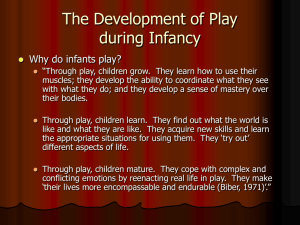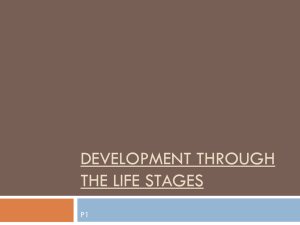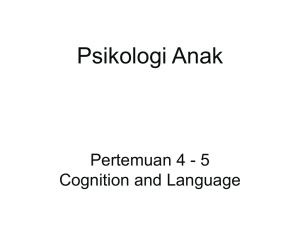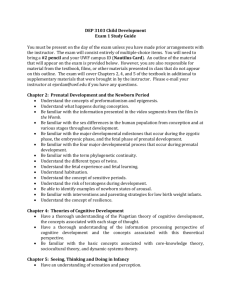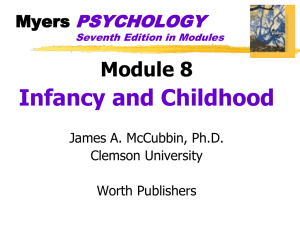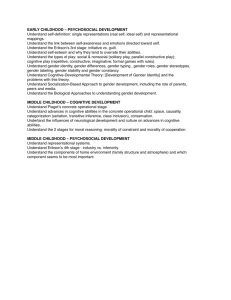Introduction to Psychology
advertisement
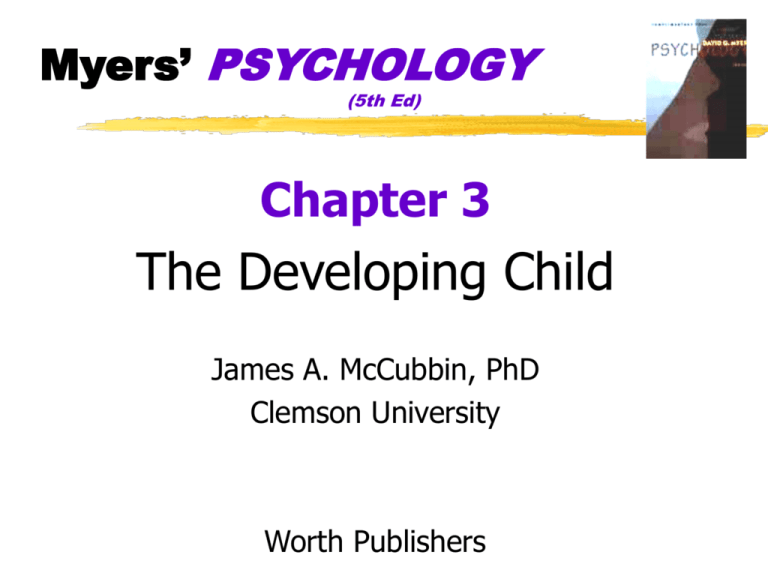
Myers’ PSYCHOLOGY (5th Ed) Chapter 3 The Developing Child James A. McCubbin, PhD Clemson University Worth Publishers The Developing Child Developmental Psychology study of changes across the life span Developmental Issues Nature versus Nurture How is our development influenced by our heredity (nature) and by our experience (nuture)? Continuity versus Stages Is developmental change gradual and continuous or does it proceed through a sequence of separate stages? Stability versus Change Do we grow into older versions of our early selves or do we become new persons? Union of Egg and Sperm Genetic Influences X- Chromosomes sex chromosome found in both males and females females have two, males have one an X-chromosome from each parent produces a female Y-Chromosomes sex chromosome found only in males when paired with a X-chromosome from the mother, it produces a male child The Developing Child Testosterone most important of the male sex hormones both males and females have it additional testosterone in males stimulates growth of male sex organs in the fetus stimulates development of male sex characteristics during puberty Gender characteristics, whether biologically or socially influenced, by which people define male and female Prenatal Development Zygote fertilized egg enters a 2 week period of rapid cell division develops into an embryo Embryo developing human organism from 2 weeks through 2nd month Fetus developing human organism from 9 weeks to birth Prenatal Development Teratogens agents that can reach the embryo or fetus during prenatal development and cause harm chemical, e.g. alcohol, some medicines, cocaine, nicotine viral, e.g. HIV, Rubella Fetal Alcohol Syndrome physical and cognitive abnormalities in children caused by drinking in pregnancy The Newborn Rooting Reflex tendency to turn head, open mouth, and search for nipple when touched on the cheek Preferences human voices and faces facelike images--> smell and sound of mother preferred Infancy and Childhood Maturation biological growth processes that enable orderly changes in behavior relatively uninfluenced by experience sets the course for development while experience adjusts it At birth 3 months 15 months Cortical Neurons Infancy and Childhood Babies only 3 months old can learn that kicking moves a mobileand can retain that learning for a month (RoveeCollier, 1989). Infancy and Childhood Impoverished environment Enriched environment Rats reared in an environment enriched with playthings show increased development of the cerebral cortex (Rosenzweig, et al., 1972). Infancy and Childhood Plasticity the brain’s capacity for modification evidence for plasticity • brain reorganization following damage –especially in children • experiments on the effects of experience on brain development Infancy and Childhood A finger-tapping task activates more motor cortex neurons after training (right). Infancy and Childhood Cognition mental activities associated with thinking, knowing, and remembering Schema a concept or framework that organizes and interprets information Assimilation interpreting one’s new experience in terms of one’s existing schemas Accommodation adapting one’s current schemas to incorporate new information Piaget’s Stages of Cognitive Development Typical Age Range Description of Stage Developmental Phenomena Birth to nearly 2 years Sensorimotor Experiencing the world through senses and actions (looking, touching, mouthing) •Object permanence •Stranger anxiety About 2 to 6 years Preoperational Representing things with words and images but lacking logical reasoning •Pretend play •Egocentrism •Language development About 7 to 11 years Concrete operational •Conservation Thinking logically about concrete •Mathematical events; grasping concrete analogies transformations and performing arithmetical operations About 12 through adulthood Formal operational Abstract reasoning •Abstract logic •Potential for moral reasoning Piaget’s Theory of Cognitive Development Object Permanence the awareness that things continue to exist even when not perceived Conservation the principle that properties such as mass, volume, and number remain the same despite changes in the forms of objects part of Piaget’s concrete operational reasoning Egocentrism the inability of the preoperational child to take another’s point of view Cognitive Development Habituation decreasing responsiveness with repeated stimulation newborns become bored with a repeated stimulus, but renew their attention to a slightly different stimulus Cognitive Development Percentage of time spent looking 80 70 60 50 40 30 20 10 0 Familiar stimulus Novel stimulus Cognitive Development Time spent looking (seconds) 40 30 20 10 0 1 2 3 4 5 Presentation 6 7 8 Cognitive Development Baby Mathematics Shown a numerically impossible outcome, infants stare longer (Wynn, 1992) 4. Possible outcome: Screen drops, revealing one object. 1. Objects placed 2. Screen in case. comes up. 3. One object is removed. 4. Possible outcome: Screen drops, revealing two object. Social Development Stranger Anxiety fear of strangers that infants commonly display beginning by about 8 months of age Attachment an emotional tie with another person shown in young children by seeking closeness to the caregiver and showing distress on separation Social Development Harlow’s Surrogate Mother Experiments Monkeys preferred contact with the comfortable cloth mother, even while feeding from the nourishing wire mother Social Development Critical Period an optimal period shortly after birth when an organism’s exposure to certain stimuli or experiences produces proper development Imprinting the process by which certain animals form attachments during a critical period very early in life Temperament a person’s characteristic emotional reactivity and intensity Social Development Monkeys raised by artificial mothers were terror-stricken when placed in strange situations without their surrogate mothers. Social Development Basic Trust (Erik Erikson) a sense that the world is predictable and trustworthy said to be formed during infancy by appropriate experiences with responsive caregivers Self-Concept a sense of one’s identity and personal worth Social Development Percentage of infants 100 who cried when their mothers left 80 Groups of infants who had and had not experienced day care were left by their mothers in a unfamiliar room. Day care 60 40 Home 20 0 3.5 5.5 7.5 9.5 11.5 13.5 20 Age in months 29 Social Development Percentage of children experiencing school problems in the previous year Percentage of children 20 15 10 5 0 Repeated school grade Expelled or suspended Treated for problems in last year Live with both biological parents Live with formerly married mother and no father Social DevelopmentChild-Rearing Practices Authoritarian parents impose rules and expect obedience “Don’t interrupt” “Why? Because I said so.” Authoritative parents are both demanding and responsive set rules, but explain reasons encourage discussion Social DevelopmentChild-Rearing Practices Permissive submit to children’s desires make few demands use little punishment Rejecting-neglecting disengaged expect little invest little Social DevelopmentChild-Rearing Practices Three explanations for correlation between authoritative parenting and social competence (1) Parent’s behavior may be influencing child. Authoritative parents (2) Child’s behavior may be influencing parents. Self-reliant, Socially competent child Authoritative parents (3) Some third factor may be influencing both parents and child. High education, ample income, harmonious marriage, common genes Authoritative parents Self-reliant, Socially competent child Self-reliant, Socially competent child Gender and Child-Rearing Gender Identity one’s sense of being male or female Gender-Typing the acquisition of a traditional masculine or feminine role Social Learning Theory we learn social behavior by observing and imitating and by being rewarded or punished Gender Schema Theory children learn from their cultures a concept of what it means to be male and female adjust behavior accordingly Gender and Child-Rearing Social learning theory Rewards and Punishments Gender schema theory Cultural learning of gender Gender schema (looking at self and World through a gender “lens”) Observation and Imitation of models Gender-organized thinking Gender-typed behavior Gender-typed behavior

